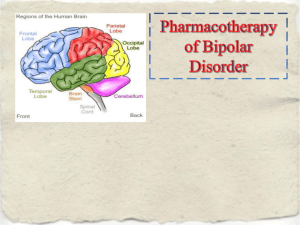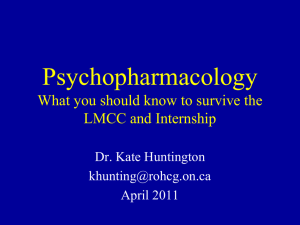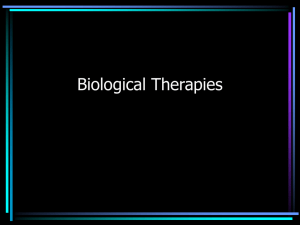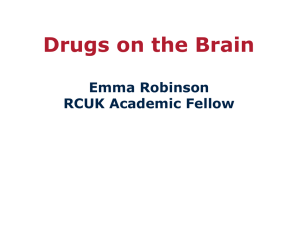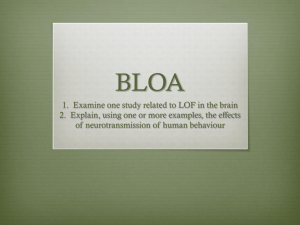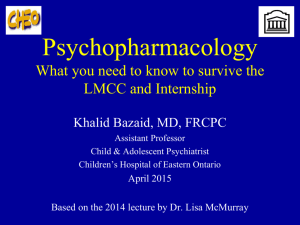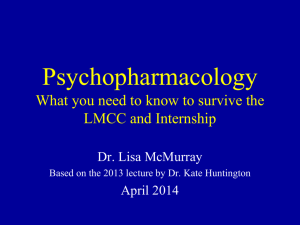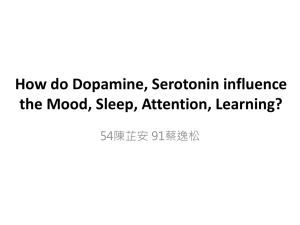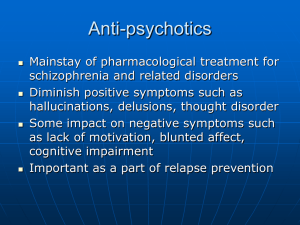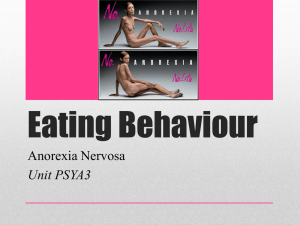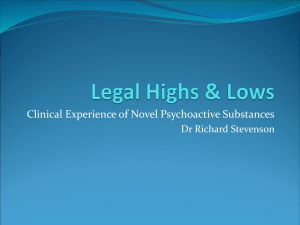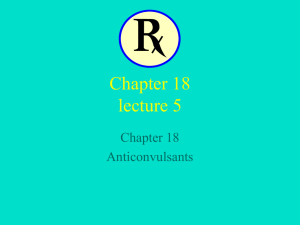4._Bipolar_disorder_def
advertisement
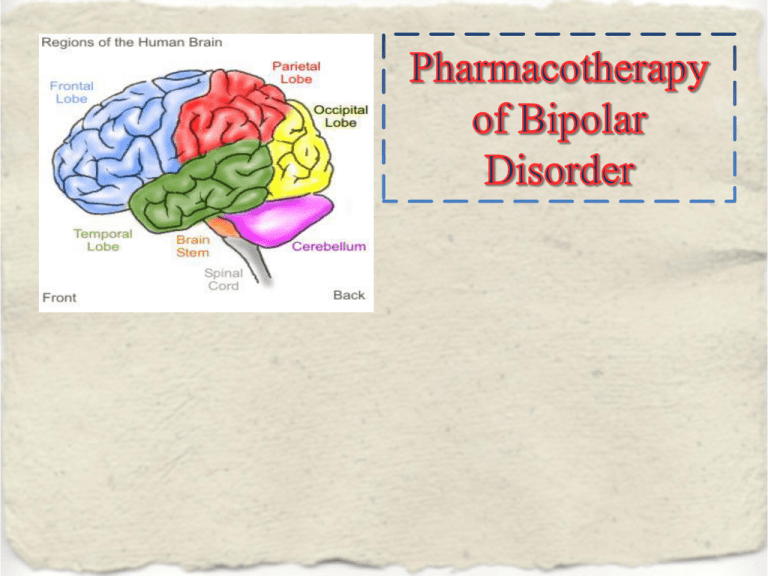
Drugs influencing CNS • psychoterapeutic drugs (antipsychotics, antidepressants, mood-stabilzing drugs) • anxiolytics, hypnotics • antiepileptics • local and general anesthetics • opioid analgesics and antagonists • drugs for neurodegenerative diseases • drugs of abuse Neurotransmitters – faciliate transmission of impulses Norepinephrine (locus coeruleus – allertness, attention, consciousness; depression) Acetylcholine (attention, learning, memory; demention, stimulate at Alzheimer´s disease) Dopamine (motoric activity, reward system; Parkinson´s disease, depression, schizophrenia) Serotonin (mood, anxiety, agressivity; Parkinson´s disease, schizophrenia) GABA (inhibitory-Cl-; benzodiazepines; anxiolytic, sedative) Glutamate (NMDA receptors; learning, memory, „cell death“ , inhibit: Alzheimer´s disease) Glycine (inhibitory-Cl-; the most common receptor in CNS) Neuropeptides Endocanabioids (enkephalins, VIP, subst.P, together with other neurotransmitters) ( NO (neuronal NOS-1988; release of neurotransmitters) nitric oxide) (neuromodulatory lipids, memory, mood, analgesia...) Most psychotherapeutics influence processes on synapse ...influence neurotransmitters Mood disorders = affective disorders Large depressive disorder Unipolar disorders Dysthymia (chronic depression) Bipolar disorder Type I (alternation of mania and depression) Type II (hypomania and depression) Cyklothymia (perzistent mood instability) Epizóda 1 2 3 4 Prevalence 5 – 6 %, men and women One episode may last 4 – 6 months; risk of suicide 60× Provoking factors Bipolar mood disorder Non-pharmacologic Approaches to the Treatment of Depression (e.g. psychotherapy, electroconvulsive therapy, repetitive trancranial magnetic stimulation, if disturbances in biorhythms – light, sleep deprivation, ...) Therapy of Depression mechanism of action of antidepressant drugs ÷ generally not fully understood ... most antidepressants have effect on synthesis, release and degradation of neurotransmitters and their interaction with receptors biogenic amine hypothesis (mood disorders result from abnormalities in serotonin, norepinephrine, or dopamine neurotransmission) NOT VALID ANTIDEPRESSANTS different divisions CLASSICAL NEWER TCA – tricyclic antidepressants IMAO – inhibitors of MAO RIMA SSRI SNRI SARI NaSSA NDRI others Tricyclic antidepresants (TCA) Chemical structure - 3 cycles (nomenclature) → significantly lipophilic substances developed from antihistaminics imipramín Mechanism of action: Block reuptake of norepinephrine (NE) and serotonin (5-HT) Dopamine neurotranssion is less influenced Most TCA block following receptors responsible for ADR: H1-receptors, -adrenoreceptors, muscarinic-receptors also outside of CNS! TCA TCA imipramine desimipramine amitriptyline nortriptyline dosulepine quinupramine clomipramine propizepine pharmacokinetics: p.o. administration, first pass effect, low variable bioavailability, strong binding to plasma proteins metabolised in liver, active metabolites CYP450 polymorfism, interactions TCA Adverse drug reaction Muscarinic receptor blockade („atropine-like“, anticholinergic) dry mouth, blurred vision – acomodation inability, obstipation, retention of urine, palpitations, tachycardia -adrenergic receptor blockade (in older age) postural (orthostatic) hypotension + reflex tachycardia H1-receptor blockade (amitriptyline) sedation, drowsiness, impaired concentration Sexual dysfunction, cardiac arrhythmias Monoamine oxidase inhibitors (IMAO) Decrease degradation of monoamines MAO is responsible for degradation of the biogenic amine neurotransmitters (norepinephrine, serotonin, dopamine) tranylcypromine – nonspecific irreversible inhibitor of MAO; tyramine reaction selegiline – treatment of Parkinson´s disease – inhibitor of MAO B (MAO B degrades DOP) „increase activity“ – euphoria + excitation IMAO tyramine reaction → combination with tyramine (indirect sympathomimetic) from food strongly increases responses to sympathicus stimuli It is mainly manifested by hypertension crisis – strong headache, risk of cerebral bleeding physiologically tyramine from food very quickly splits MAO, at pharmacological inhibition (irreversible) with MAO it isn´t possible → patients taking IMAO must avoid intake of tyramine → strict dietary regimen!! main sources of tyramine in food: cheese, bier, IMAO ADRs: postural hypotension CNS stimulation: tremor, excitation, insomnia, spasms increased apetite Tox.: hepatotoxicity RIMA - reversible inhibitors of MAO A moclobemid –– MAO A degrades SER, DOP and NE Selective Serotonin Reuptake Inhibitors - SSRI Indications: antidepressants anxiety disorders, OCD bulimia, gambling Fluoxetine Fluvoxamine Paroxetine Sertaline Citalopram Escitalopram pharmacokinetics: p.o. administration Polymorfism of metab. in liver (2D6, 2C19) Long T1/2 (50 h) Interactions – biding to plasma proteins: TCA, betablockers, benzodiazepines SSRI ADRs --- better profile than TCA and IMAO GIT – nausea, vomitting, abdominal spasms, accelerated peristalsis, diarrhea Headache Sexua dysfunction Akathisia Insomnia and fatigue Sometimes - increased anxiety / agitation at the beginning of therapy Serotonin syndrome at intoxications or interactions Serotonin syndrome Also after 1 dose of SSRI ! Symptoms – soon, till 6 hours Neuromuscular: akathisia, tremor, hyperreflexia, myoclonus, hypertonicity Change in mental status: agitation, delirium Autonomic hyperactivity: tachycardia, midriasis, sweatting, increased motility of GIT, hyperthermia Serotonin syndrome RISK – COMBINATION OF DRUGS SSRI + inhibitors of CYP 450 SSRI + serotoninergic AD (trazodone, clomipramine, venlafaxine) SSRI + IMAO SSRI + lithium SSRI + analgetics (tramadol, fentanyl, pentazocine), SSRI + antiemetics (metoclopramide), antimigraine drugs (sumatriptan) SSRI + antibiotics (linezolid), others: ritonavir, dextromethorphan, LSD.... Selective Serotonin and Norepinephrine Reuptake Inhibitors (SNRI): venlafaxin Selective Serotonin Norepinephrine ane Dopamine Reuptake Inhibitors (NDRI): bupropion Selective Norepinephrine Reuptake Inhibitors (NaRI): reboxetine Serotonin Antagonists and Reuptake Inhibitors(SARI): trazodone Noradrenergic and Specific Serotonergic Antidepressant (NaSSA): mirtazapine (increases noradrenergic and serotonin transmission; influence on receptors: 1,2, a 5HT1A ,5HT1B) SSRE Selective Serotonin Reuptake Enhancer Reduces effect of serotonin in limbic system 3x / day, effect starts already after 1. week ADRs: dry mouth, obstipation, nausea postural. hypotension, tachycardia insomnia, nightmares, dizziness, collapse Don´t administer together with IMAO ! ? Biogenic amine hypothesis Agomelatine • Receptors for melatonine (subtype – MT1 and MT2, nucleus suprachiasmaticus) and serotonin (5HT2C- frontal cortex, hipocampus) in CNS • Efect similar to melatonine • Resynchronises cirkadian rhythms Alprazolam • benzodiazepine • Anxiolytic effectt at generalized anxiety (neurosis) till 20 min. • Depression – latency of effect 1-6 weeks • Neuroprotective effect (unlike other benzodiazepines) Bipolar affective disorder Therapy of Bipolar Disorder – mood stabilizing drugs Acute treatment - 2 months - manage mania ÷ depression Stabilizing treatment - 6 months – prevention of recurrence Prophylactic treatment- 12 months..... – long-term prophylaxy A. Therapy of mania Bipolar affective disorder Goal: influence irritability, agitation, agressivity, impulsivity Lithium Selected antiepileptic drugs (valproic acid, carbamazepine, clonazepan, lamotrigine) Atypical antipsychotics – olanzapine, risperidone, quetiapine, aripiprazole B. Therapy of bipolar depression Goal: no depressive symptomatology ATTENTION reoccurence of mania in (20-40%!) Lithium Antidepressants (TCA, SSRI) Lamotrigine, quetiapine Bipolar affective disorder Lithium •In contrast to other antidepressants effective mainly in manic phase, used mainly as prophylaxis of bipolar depression •Mechanism of action unclear: -interference with Na+/K+ ATPase -interference with cAMP formation -interference with inositol phosphates formation -numerous and complex effect on neurotransmitter systems •Very small therapeutic range: 0,5-1,0 mmol/l Lithium •Before treatment needed to exclude cardiopathia and nephropathia •ADR: - at the treatment beginning: GIT problems, tiredness, shaking of fingers of hand; dissapear in several weeks - late: polydipsia, polyuria, hypothyreosis, increased weight, cardiopatia, forgetting, teratogenic effects •Intoxication: tremor, twitching, apathia, muscle weekness, convulsions, coma •Many drug onteractions – e.g. increased lithemia at simultaneous administration of diuretic and antirheumatic drugs Drug Induced Psychiatric Disorders Other Selected Drugs Antipsychotics (Neuroleptics) Indications: • Psychiatric – Psychoses – including delusions, hallucinations, disordered thoughts (particularly in shizophrenia and bipolar disorder) – At conditions of acute patologic agressivity and agitation (chlorpromazine, levopromazine, haloperidol) • Nonpsychiatric – Antiemetic effect – already at low doses (e.g. thiethylperazine – suppositories, injections) – Neuroleptanalgezie – droperidol + fentanyl Antipsychotics (Neuroleptics) Contraindications: intoxiction with substances depressing CNS, neuroleptic malignant syndrome history, Parkinson´s syndrome, be carefull at patients with kidney and liver problems Antipsychotics (Neuroleptics) Mechanism of action: All antipsychotic drugs tend to block D2 receptors in the dopamine pathways of the brain. This means that dopamine released in these pathways has less effect. Excess release of dopamine in the mesolimbic pathway has been linked to psychotic experiences. Typical antipsychotics are not particularly selective and also block dopamine receptors in the mesocortical pathway, tuberoinfundibular pathway, and the nigrostriatal pathway – ADR. Atypical antipsychotic drugs have a similar blocking effect on D2 receptors. Some also block or partially block serotonin receptors (particularly 5HT2A, C and 5HT1A receptors) – can influence the "negative symptoms" of schizophrenia. Antipsychotics (Neuroleptics) Antipsychotics (classical) typical atypical (clozapine, risperidone) basal (chlorpromazine) incisive (haloperidol) I. Typical (1st generation) neuroleptics • a) basal (sedative): - chlorpromazine (model drug, phenothiazine structure) - levomepromazine - chlorprothixene, thioridazine • b) incisive: - haloperidol (model drug, butyrophenone structure) - fluphenazine, flupenthixol, clopenthixol II. Atypical (2nd generation) neuroleptics • „Multi Acting Receptor Targeted Antipsychotics“ (MARTA) – olanzapine, zotepine, quetiapine, – clozapine – Blokujú D1/2, α, H1, M a 5-HT2 receptory • „Serotonin and Dopamin receptor antagonists“ (SDA) – risperidone, ziprasidone • D2-selektívne antagonisty – sulpiride, amisulpiride Antipsychotics (Neuroleptics) - ADRs blockade of dopamine receptors – extrapyramidal side effects, hyperprolactinaemia anticholinergic – sinus tachycardia, obstipation, retention of urine, dry mucosas, mouth, disturbances of acomodations, increased intraoccular pressure, etc. antiadrenergic – ortosthatic hypotension, impotence, etc. antihistaminic – sedation, weight gain, etc. Neuroleptic malignant syndrome Extrapyramidal ADRs ADRs type A • • D2 blockade in striatum more frequent after typical incisive neuroleptics – Acute (reversible) • Parkinson´s syndrome: tremor, muscle rigidity, hypokinesia/akinesia: • Acute dystonia – painful muscle spasms, till 24-96hours – – – – Orofacial muscles – e.g. blepharospasmus (eye lashes), oculogyric crisis – upward deviation of the eyes … Neck muscles (torticollis) Protrusion of the tongue Pharyngo-laryngeal muscles – life-threatening • Akathisia – Interanl sence of motor restlessness („restless leg syndrome“) . Treatment: benzodiazepines, beta-blockers. Extrapyramidal ADRs ADRs type A • Late (often irreversible) – Tardive dyskinesia » Uncontrolled movements of face/tongue and limbs » Development after months even years of treatment » Bizarre movements of tongue, chewing, „rabbit lip syndrome“ – problems with speaking and eating, facial grimaces … » Choreiform movements of limbs » up-regulation of D-receptors in striatum? Neuroleptic Malignant Syndrome ADR type B – All neuroleptics – (potent D2-blockers probably more) – Rare (incidence 0.07-0.2%) – Potentially life-threatening condition (mortality cca 5-12%) – Clinical symptoms • severe muscle rigidity, hyperthermia (>38ºC), profuse sweating, tachycardia, tremor, altered mental functions – Mechanism – excessive blockade of D2 in striatum and hypothalamus? – Treatment • Cooling of the body ! + antipyretics • D2-agonists – bromocryptine, amantadine + D-precursors (L-DOPA) • Dantrolen – blocks Ca2+ release – controversial Antipsychotics classical (typical) atypical (↑ AP ef., ↓ EP ADR, ↓ other ADR) basal (↓ AP ef., ↓ EP ADR ↑ other ADR) incisive (↑ AP ef., ↑ EP ADR ↓ other ADR) Benzodiazepines have hypnotic, anxiolytic, anticonvulsive, muscle relaxant, amnestic effects – difference according to the site to which they on receptor bind !!! interaction with s alcohol!!! antidote of benzodiazepines - specific antagonist FLUMAZENIL γ-AMINOBUTIRIC ACID receptor of GABA-A opens or closes Cl- channels, alosterically modulated by benzodiazepine receptors, and also by nonbenzodiazepine hypnotics subtype of receptor and its localisation: 1-benzodiazepine receptor – anxiolytic sedative effect, highest density in cerebellum GABA-B binding of muscle 2-benzodiazepine receptor – myorelaxant relaxants effect, in striatum and spine (BACLOFEN) 3-benzodiazepine receptor – in kidneys, Benzodiazepines (max. 4-6 weeks) stress situation leading to anxiety is temporary and removable rebound phenomenon if the patient is too calm, he is loosing motivation anticonvulsive and myorelaxant effect, rapid onset of effect of some benzodiazepines (after parenteral administration) → → therapy of emergency conditions! (status epilepticus, intoxications with spasms) classically diazepam, recently promoted lorazepam (a lower risk of recurrence)
